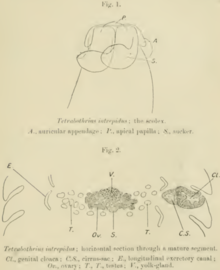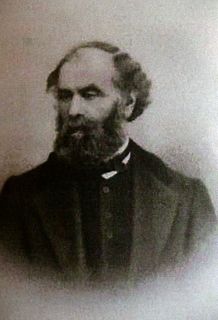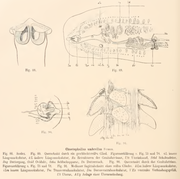| Tetrabothriidea | |
|---|---|
 | |
| Tetrabothrius intrepidus | |
| Scientific classification | |
| Kingdom: | Animalia |
| Phylum: | Platyhelminthes |
| Class: | Cestoda |
| Subclass: | Eucestoda |
| Order: | Tetrabothriidea Baer, 1954 |
Tetrabothriidea is an order of helminths in the class Cestoda. It consists of only one family, Tetrabothriidae. Their hosts are mainly seabirds, the rest being cetaceans and pinnipeds. [1]

The flatworms, flat worms, Platyhelminthes, Plathelminthes, or platyhelminths are a phylum of relatively simple bilaterian, unsegmented, soft-bodied invertebrates. Unlike other bilaterians, they are acoelomates, and have no specialized circulatory and respiratory organs, which restricts them to having flattened shapes that allow oxygen and nutrients to pass through their bodies by diffusion. The digestive cavity has only one opening for both ingestion and egestion ; as a result, the food cannot be processed continuously.
In biological classification, class is a taxonomic rank, as well as a taxonomic unit, a taxon, in that rank. Other well-known ranks in descending order of size are life, domain, kingdom, phylum, order, family, genus, and species, with class fitting between phylum and order. As for the other well-known ranks, there is the option of an immediately lower rank, indicated by the prefix sub-: subclass. For example, dogs are in the class Mammalia.

Cestoda is a class of parasitic worms in the flatworm phylum (Platyhelminthes). Most of the species - and the best-known - are those in the subclass Eucestoda; they are ribbonlike worms as adults, known as tapeworms. Their bodies consist of many similar units, known as proglottids, which are essentially packages of eggs which are regularly shed into the environment to infect other organisms. Species of the other subclass, Cestodaria, are mainly fish parasites.












